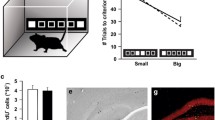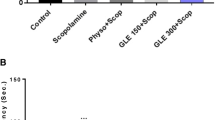Abstract
Khat products and chewing practices are common in East Africa, Middle East for centuries with concomitant socio-economic and public health repercussions. We assessed memory deficits associated with khat use in rodents. Young male CBA mice, 5–7 weeks old (n = 20), weighing 25–35 g were used. Mice were treated with either 40, 120 or 360 mg/kg body weight (bw) methanolic khat extract, or 0.5 ml saline for 10 days. Spatial acquisition, reversal and reference memory were assessed using modified Morris Water maze (MMWM). Mice treated with 40 mg/kg khat extract had longer (t4 = 4.12 p = 0.015) and t4 = 2.28 p = 0.065) escape latency on first and second day during reversal relative to the baseline. Under 120 mg/kg khat dose, the escape latency was shorter (t4 = −2.49 p = 0.05) vs (t3 = −2.5 p = 0.05) on third and fourth day. Further, treatment with 360 mg/kg khat extract resulted in significantly longer time (49.13, 33.5, 40.2 and 35.75) vs. (23.5 s), compared to baseline. Mice treated with khat or control preferred the target quadrant post acquisition while differential pattern was seen during reversal phase. Mice treated with 40 or 120 mg/kg khat showed significant preference for target quadrant. Substantial time (19.9) was spent in the old target compared to the new (16.9 s) by animals treated with highest dose however, the difference was not significant. There is a biological plausibility that chronic khat use may induce memory deficits and impair cognitive flexibility. The differential patterns of memory deficits may reflect the differences in dose effect as well as time dependent impairment.



Similar content being viewed by others
References
(1975) United Nations Narcotic Laboratory Studies on the chemical composition of khat. Investigations on the phenyalkylamine fraction. MNAR/11/75
Al-Motarreb A, Baker K, Broadly KJ (2002) Khat: pharmacological and medicinal aspects and its social use in Yemen. Phytother Res 16:402–413
Al-Motarreb A, Al-Habori M, Broadley KJ (2010) Khat chewing, cardiovascular diseases and other internal medical problems: the current situation and directions for future research. J Ethnopharmacol 132:540–548
Balint E, Falkay G, Balint G (2009) Khat—a controversial plant. Wiener klinische Wochenschrift. Middle Eur J Med 121:604–614
Banjaw MY, Mayerhofer A, Schimidt WJ (2003) Anticataleptic activity of cathinone and MDMA (Ecstacy) upon acute and subchronic administration in Rat. Synapse 49:232–238
Bantick RA, Deakin JF, Grasby PM (2001) The 5-HT1A receptor in schizophrenia: a promising target for novel atypical neuroleptics. J Psychopharmacol 15:37–46
Berke JD, Hayman SE (2000) Addiction dopamine and the molecular mechanism of memory. Neuron 25:515–532
Brenneisen R, Fisch HU, Koelbing U, Geisshüsler S, Kalix P (1990) Amphetamine-like effects in humans of the khat alkaloid cathinone. Br J Clin Pharmacol 30:825–828
Bromley-Brits K, Deng Y, Song W (2011) Morris water maze test for learning and memory deficits in Alzheimer’s disease model mice. J Vis Exp (53):e2920. doi:10.3791/2920
Brown RE, Stanford L, Schellink HM (2000) Developing standardized behavioural test for knockout and mutant mice. Inst Lab Anim Res J 41:163–174
Carlini EA (2003) Plants and the central nervous system. Pharmacol Biochem Behav 75:501–512
Colzato LS, Ruiz MJ, Wildenberg WP, Hommel B (2011) Khat use is associated with impaired working memory and cognitive flexibility. PLOS One. Published: June 15, 2011
Connor JD, Rostom A, Makonnen E (2002) Comparison of effects of khat extract and amphetamine on motor behaviours in mice. J Ethnopharmacol 81:65–71
Devan BD, Goad EH, Petri HL (1996) Dissociation of hippocampal and striatal contributions to spatial navigation in the water maze. Neurobiol Learn Mem 66:205–323
Eddy NB, Halbach H, Isbell H, Seevers MH (1965) Drug dependence; its significance and characteristics. Bull WHO 32:721–733
Gebissa E (2010) Khat in the horn of Africa: historical perspectives and current trends. J Ethnopharmacol 132:607–614
Gray JA, Roth BL (2007) Molecular targets for treating cognitive dysfunction in schizophrenia. Schizophr Bull 33:1100–1109
Hoffman R, Absi M (2010) Khat use and neurobehavioral functions: suggestions for future studies. J Ethnopharmacol 132:554–563
Hoffman R, al’Absi M (2013) Working memory and speed of information processing in chronic khat users: preliminary findings. Eur Addict Res 19:1–6
Kalix P (1990) Pharmacological properties of the stimulant khat. Pharmacol Ther 48:797–816
Kalix P (1992) Cathinone: a natural amphetamine. Pharmacol Toxicol 70:79–86
Keefe RS, Harvey PD (2012) Cognitive impairment in schizophrenia. Handb Exp Pharmacol 213:11–37
Killcross AS, Dickson A, Robbins TW (1994) Amphetamine-induced disruptions of latent inhibition are reinforcer-mediated: Implications for animal model of schizophrenic attentional dysfunction. Psychopharmacology 115:185–195
Kimani ST, Nyongesa AW (2008) Effects of single daily khat (Catha edulis) extract on spatial learning and memory in CBA mice. Behav Brain Res 195:192–197
Kirkyby RJ (1969) Caudate nucleus lesions and perseverative behavior. Physiol Behav 4:451–454
Küçük A, Gölgeli A, Saraymen R, Koç N (2008) Effects of age and anxiety on learning and memory. Behav Brain Res 95:147–152
Lin B, Brucher FA, Colgin LL, Lynch G (2002) Long term potentiation alters the modulator pharmacology of AMPA-type Glutamate receptors. J Neurophysiol 87:2790–2800
Meltzer HY, Sumiyoshi T (2008) Does stimulation of 5-HT1A receptors improves cognition in schizophrenia. Behav Brain Res 195:98–102
Metzger RR, Hanson GR, Gibb JW, Fleckenstein AE (1998) 3, 4 Methylenedioxy- methamphetamine- induced acute changes in dopamine transporter function (synopsis). Eur J Pharmacol 349:206–210
Millan MJ (2000) Improving the treatment of schizophrenia: focus on serotonin (5-HT-1A) receptors. J Pharmacol Exp Ther 295:853–861
Mohammed F, Gerbi A, Teffera A, Seyoum G, Nedi T, Engidawork E (2014) Subchronic crude khat (Catha edulis f.) extract administration produces short-term memory impairment in behavioral tasks without morphological toxicity to the dentate gyrus in mice. Ethiop Pharm J 30(2)
Mohammed F, Engidawork E, Nedi T (2015) Evaluations of the effect of subchronic administration of crude khat extract (Catha edulis f.) on learning and memory in mice. Neurology 84(14 Supp.)
Mora PO, Netto CF, Graeff FG (1997) The role of 5-HT2A and 5-HT2C receptor subtypes in the two types of fear generated by the elevated T-maze. Pharmacol Biochem Behav 58:1051–1057
Morris RGM (1981) Spatial localization does not require the presence of local cues. Learn Motiv 12:239–260
Nguyen PV (2007) Comparative plasticity of brain synapses in inbred mouse strains. J Exp Biol 209:2293–2303
Nguyen PV, Abel T, Kandel ER, Bourtchouladze R (2000) Strain-dependent differences in LTP and hippocampus-dependent memory in inbred mice. Learn Mem 7:170–179
Odenwald M, Hinkel H, Schauer E, Schauer M, Elbert T, Neuner F, Rockstroh B (2009) Use of khat and posttraumatic stress disorder as risk factors for psychotic symptoms: a study of Somali combatants. Soc Sci Med 69:1040–1048
Pezze MA, Feldon J, Murphy CA (2002) Increased conditioned fear response and altered balance of dopamine in the shell and core of the nucleus accumbens during amphetamine withdrawal. Neuropharmacology 42:633–643
Robinson TE, Kolb B (1997) Persistent structural modifications in nucleus accumbens and prefrontal cortex neurons produced by previous experience with amphetamine. J Neurosci 17:8491–8497
Russing H, Durrer A, Yee BK, Murphy CA, Feldon J (2003) The acquisition retention and reversal of spatial learning in the Morris water maze task following withdrawal from an escalating dosage schedule of amphetamine in Wistar rats. Neuroscience 119:167–179
Safer DJ, Krager JM (1998) A survey of medication treatment for hyperactivity/in-attentive students. J Am Med Assoc 260:2256–2258
Segal DS, Kuczenski R (1997) An escalating dose “binge” model of amphetamine psychosis: behavioral and neurochemical characteristics. J Neurosci 17:2551–2566
Sheikh A (2014) Somali ‘paradise flower’ chewers savor low-price bliss after UK ban. Reuters.com
Szendrei K (1980) The chemistry of khat. Bull Narc 32:5–35
Vorhees CV, Williams MT (2006) Morris water maze: procedures for assessing spatial and related forms of learning and memory. Nat Protoc 1:848–858
Yucel M, Lubman D, Harrison B, Fornito A, Allen N, Wellard R, Roffel K, Clarke K, Wood S, Forman S, Pantelis C (2007) A combined spectroscopic and functional MRI investigation of the dorsal anterior cingulated region in opiate addiction. Mol Psychiatry 12:691–702
Zelger JL, Schorno HX, Carlini EA (1980) Behavioural effects of Cathinone, an amine obtained from Catha edulis Forsk: comparison with amphetamine, norpseudoephedrine, apomorphine and nomifensine. Bull Narc 32:67–81
Zhou J, Li L, Tang S, Cao X, Li Z, Li W, Li C, Zhang X (2008) Effects of serotonin depletion on the hippocampal GR/MR and BDNF expression during the stress adaptation. Behav Brain Res 195:129–138
Acknowledgments
This work was supported by Department of Medical Physiology, University of Nairobi. The authors wish to thank Mr. Charles Nzivo, of the Department of Medical Physiology, University of Nairobi, for his logistical assistance.
Author information
Authors and Affiliations
Corresponding author
Ethics declarations
Conflict of interest
The authors declare no conflict of interest.
Rights and permissions
About this article
Cite this article
Kimani, S.T., Patel, N.B. & Kioy, P.G. Memory deficits associated with khat (Catha edulis) use in rodents. Metab Brain Dis 31, 45–52 (2016). https://doi.org/10.1007/s11011-015-9738-1
Received:
Accepted:
Published:
Issue Date:
DOI: https://doi.org/10.1007/s11011-015-9738-1




